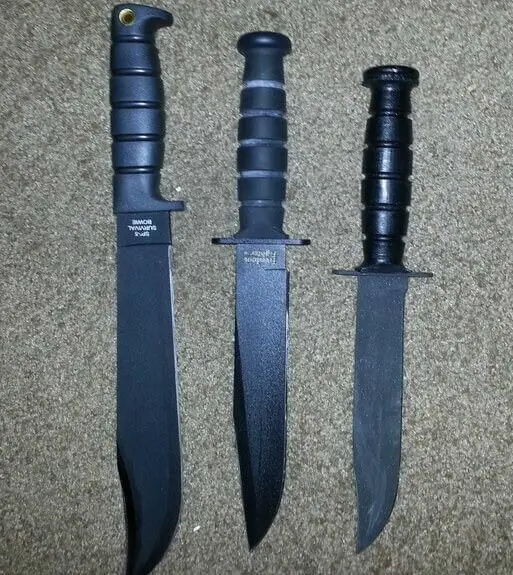Bowie knife vs Kabar, which one to choose?
The Bowie knife has a curved blade with a cut-out section near the tip, whereas Ka-Bar knives have a straight cutting edge with a less prominent clip point. A Bowie is suitable for tasks like hunting, where you can use the belly for slicing and the tip for skinning and butchering game. Ka-Bar knives on the other hand are good at almost everything, whether it’s making uniform cuts, prepping food, or carving.
There are other factors to consider, like weight, balance, and the length of the blades. You’ll learn all of that and much more about these knives here.
Ka-Bar Knife Vs. Bowie Knife: An Quick Overview
| Subject | Bowie Knife | KaBar Knife |
| Blade Weight | Heavier | Lighter |
| Knife Balance | Towards the Blade | Towards the Handle |
| Blade Length | Between 5 and 12 Inches | About 7 Inches Long |
| Uses | Hunting, Camping, Piercing, Thrusting, Chopping, Carving, Slicing, Self-Defense | Splitting Wood, Prepping Fish, Utility Tasks, Combat, Survival, Tactical |
| Geometry | Curved Blade With a Clip Point | Straight Blade With a Clip Point |
| Origin | 19th Century as a Self-Defense Weapon | 1942 as a World War II Weapon |
| Legality | Limited | Limited |
| Evolution | New Features Added | Core Design Sticks to Original Ka-Bar Knife |
8 Key Differences Between Bowie and Ka-Bar Knife
There are eight differences between Ka-Bar vs bowie knives, and each difference affects how you use each knife.
Origin
The Bowie knife dates back to the 19th century when James Black designed and created the knife for James Bowie. James Bowie was a famous fighter that popularized the Bowie knife as a fighting knife after using it to defeat three attackers. While the Bowie knife changed over the years, the term still refers to a large sheath knife with a cross guard and a blade with a clip point.
Ka-Bar knives rose to popularity in 1942 when the United States Marine Corps adopted them as the official combat knife. This knife came as an improvement for the military because soldiers were still using trench knives from the World War I era. The Ka-Bar offered more fighting grip positions, and a stronger blade to cut wire or open cans.
Blade Weight
Modern Bowie knives weigh between 10 and 15 ounces. Bowie knives are heavier, and their weight can affect the usability of the knife. Holding a knife for continuous use tires your hand, leading to potential wrist pain or fatigue. As a result, your cutting accuracy won’t be the same.
One of the lightest is the Buck Knives 119 Bowie knife, which weighs 10 ounces and feels comfortable to hold. The heaviest is the NedFoss 13″ Bowie knife, which weighs 15.1 ounces.
Ka-Bar knives are slightly lighter, weighing between 9.6 and 11.2 ounces. The KA-BAR TDI Knife is one of the lightest available, and it offers many convenient benefits. For example, it has a lightweight build that allows you to use the knife longer. There are fewer risks of experiencing wrist fatigue, which is perfect if you’re outdoors.
Knife Balance
Bowie knives have a balance point about 1.5 inches in front of the cross guard. This design provides moderate balance, with most of the weight feeling towards the center of the blade. The best method to use this balance point to your advantage is with a hammer grip. With this holding technique, you can slash and thrust without losing stability.
Ka-Bar knives have a balance point between the handle and the blade, offering superior balance. This design favors the handle, providing a sturdy grip with total control over the tip and cutting edge of the blade. As a result, it’s easier to complete fine tasks because the knife is more manageable.
Blade Length
A Bowie knife blade ranges between 5 and 12 inches. Longer Bowie knives can measure about 18 inches in length, offering plenty of reach to use the Bowie as a self-defense weapon. It’s the size of a knife that you want to establish distance between you and another person or an animal.
Larger blades are also better for chopping tree branches or firewood because they provide more leverage. The downside to larger blades is that they’re usually heavier, not easily controllable, unable to do precise tasks and can feel tiring very quickly.
Ka-Bar blades are usually 7 inches long. There are even smaller blades of 4 inches like the Ka-Bar 2-1232-1, but they’re rare. Shorter blades are more controllable, and you can use them for cutting, slicing, or making fine cuts with high precision. Plus, it’s more convenient to carry a knife with a small blade than a larger Bowie knife because some states may consider it illegal.
The downside to small Ka-Bar blades is that they’re not suitable for heavy-duty work and lack resistance. You can’t use them for chopping or batoning through thicker materials.
Uses
The Bowie knife is the perfect tool for hunting, camping, and other outdoor activities. Larger Bowie knives can pierce and penetrate the thicker skin of big game, which is essential for hunters. Additionally, this type of knife can chop branches and logs. Other applications for Bowie knives include carving wood, slicing vegetables, and self-defense. It’s also a fantastic butcher knife for cutting meat.
A Ka-Bar knife is good at many things, but it doesn’t excel in any particular area. It can cut and split wood, cut heads off of fish, and help with chores around the house like chopping fruits or vegetables. Originally, this knife was a combat survival weapon designed for the marines. Now, knife maker KA-BAR creates knives for tactical and utility purposes.
Geometry
A Bowie knife has a curved blade with a clip point. The clip point style consists of a cut-out section near the tip that is either straight or with a curvature. This shape creates a fine and narrow tip that can pierce and stab with ease, as seen in the Cold Steel Marauder Bowie Knife. Also, the blade has a hollow grind with a thin cutting edge that cuts through and reaches deeply into the material.
The Ka-Bar knife has a straight clip point blade, but the width is thinner and not as strong as the Bowie knife. As a result, this knife style wouldn’t stand against heavy-duty use like batoning applications. Instead, the low profile of the blade makes it suitable for precision work like carving or whittling. Additionally, Ka-Bar knives may or may not have a partially serrated blade section near the heel.
Legality
Ka-Bar knives have smaller blades that fall within the limits established by the law in many places. For example, you can carry Ka-Bar knives freely in places like California and Texas. Another issue to consider is that Ka-Bar features fixed blades, which can also be illegal depending on where you live.
The Bowie knife is illegal to carry in many states across the United States. Lawmakers consider the Bowie knife a “deadly weapon” and “dangerous,” which is why there are rules against it. Still, other states have no issue if you carry a Bowie knife as long as you keep it concealed, like in a leather sheath. Make sure to read the laws of your state or country to avoid any issue with the law.
Evolution
The Bowie started as a weapon for knife fighting, but it evolved through the years to become a knife style. Currently, knife makers have their own approach to what a Bowie knife should be. Manufacturers maintain the large blade with a clip point, but they also add their unique features to it.
Ka-Bar is a defined knife that served the purpose of backing up the military in combat. These knives have only small variations over the years, like the addition of serrations on the blade. However, these perks don’t make a significant difference.
Is a Ka-Bar a Bowie Knife?
Bowie knives and Ka-Bar knives are not the same things. The Bowie has a heavier blade, and it has evolved through the years, with knife makers making different versions. A Ka-Bar blade is thinner, more balanced, and lighter. Ka-Bar style knives were initially for the military, while the Bowie knife was a self-defense tool for personal use.
Do Marines Still Use Ka-Bar Knives?

Marines mostly use the OKC-3S, which draws inspiration from the Ka-Bar style knives. However, the Ontario Knife Company makes the OKC-3S and not Ka-Bar Knives.
Does the USMC Still Issue Ka-Bar Knives?
No, the USMC transitioned from Ka-Bar style knives to the OKC-3S. The OKC-3S is a multipurpose bayonet more durable than its predecessors.
What’s a Ka-Bar Style Knife Blade?
The Ka-Bar style blade is a fixed blade design first used by the US Marines during the Second War. Ka-Bar blades are large, usually 7 inches (178 mm) long, with a clip point tip. This blade style can have a flat edge like the Ka-Bar 9191 or a partially serrated heel like the KA1218-BRK. Nowadays, the Ka-Bar style blade is suitable for opening cans, digging trenches, and cutting wire, cable, or wood.
Are Bowie Knives Good for Self Defense?
The clip point blade of the Bowie knife can pierce, stab, and slash with ease, making the knife suitable for self-defense. Bowie knives also have a hand guard to keep the hands protected while thrusting. A pointy tip and a firm grip make the Bowie nimble enough to incapacitate someone.
Ka-Bar or Bowie: Which One Should You Choose?
Choose a Bowie knife if you want a versatile outdoor tool for hunting, camping, or hiking. This knife is strong to chop down branches, versatile to skin and butcher game, and a reliable survival knife with a pointy tip for penetration. A large bowie knife can be heavy, but the weight could be an advantage in your favor considering the intended uses of the blade. You can use the Bowie knife in a slashing cutting motion to allow the heavy blade to do the cutting job.
If you want a utility knife for everyday use, then the Ka-Bar knife is for you. This knife can do pretty much any light task you need, whether it’s cutting or chopping thinner materials. Ka-Bar knives also have a straight cutting edge ideal for making uniform cuts. The blade makes contact over the cutting surface at once, which guarantees clean cuts every time. Consider all of these differences before choosing between bowie knife vs Ka-Bar.

